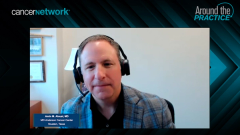
Understanding the Pathophysiology of Acute vs Chronic GVHD
Shared insight on the pathophysiology of graft vs host disease, with specific regard for differences between acute GVHD vs chronic GVHD.
Episodes in this series

Transcript:
Yi-Bin Chen, MD: Let’s talk a little bit about graft versus host disease [GVHD] itself. Nelson, can you tell us briefly about the symptoms of acute GVHD and what we believe is the pathophysiology behind it?
Nelson J. Chao, MD, MBA: We know that it’s a T-cell–mutated disease, so if you do an extensive T-cell ablation you don’t see that. Of course, you end up with problems of nongraft and relapse if you don’t have any T-cells either, but it’s T-cell mediated. It’s dependent on T cell recognition of allogeneic peptides presented by MHC [major histocompatibility complex]. In the acute setting it’s much more of an acute inflammatory response, which isn’t terribly different from cytokine release type symptoms where you end up having significant damage to the gut, the skin, and the liver. We think that it’s the gut microbiome that drives the donor T cells to be activated and then from the gut, it might go to the other organs but it’s predominantly a disease of the skin, gut, and liver. However, we can also sometimes see CNS [central nervous system] disease, and lung disease.
Yi-Bin Chen, MD: I think we have all accepted that form of pathophysiology for acute GVHD. I think the discussion around chronic graft versus host disease pathophysiology is a bit more complicated. Hana, can you talk briefly about what the symptoms are for chronic graft versus host disease? What are we thinking about in terms of pathology there?
Hana F. Safah, MD: You’re right. Exactly. There is a big difference between how the patient presents with acute GVHD compared with those who presented with chronic GVHD. For those who present with chronic, I usually like to tell them to expect something like an autoimmune disease, where symptoms can creep up slowly. We don’t have this angry kind of reaction that we see with acute where a rash is all over and it’s angry and red. For chronic disease, you see some changes in the skin such as sclerotic changes, and then that will progress into involvement of the joint, with limitation in the range of motion. Some patients come in because they cannot do the work they used to do. An example is if the patient is a hairdresser and they cannot use their hand as they used to in the past, or if they have dry eyes, dry mouth, or maybe some ulcers in the mouth; these are usually the symptoms. You’ll see mucocutaneous symptoms, and then when you start looking at other organ involvements, you might see liver involvement. Usually, patients also have weight loss. Whenever a patient starts complaining of weight loss, I always think that it is chronic GVHD. The interesting part is that chronic GVHD can mimic anything, so when I see a patient who had stem cell transplant in the past and is coming in with a weird symptom, I am thinking chronic GVHD. I had patients with nephrotic syndrome who have presented with chronic GVHD. The mechanism is somehow different from acute GVHD, but it’s related. It starts in the gut, with T cells being activated, then we have the loss of the thymus with the dysregulation of the immune system. This causes less TREX [
also, and then we have these follicular helper T cells in the lymph nodes that are related to expansion of these aberrant B cells. I think B cells play a very important role when it comes to chronic GVHD. These aberrant B cells are antihost B-cells. They evolve into plasma cells that secrete these antibodies, so here comes the humeral effect of chronic GVHD, then comes activation of the macrophage, the fibroblast, and we end up with fibrotic part of the chronic GVHD. That’s what makes our patient sick. When you think of these phases, you are trying to stop it before it reaches the end part, or the third phase, of GVHD. This is also known as the fibrotic phase because it carries the symptom burden and the decrease in quality of life, whether physiologic or functional. I hope I made it clear.
Yi-Bin Chen, MD: I think it’s clearly unclear because there are so many pathways involved. It’s a very heterogeneous disease that can involve almost any organ. Because of the multiple pathways involved, therapy has shifted to target some of those pathways that we'll talk about.
Transcript edited for clarity.
Newsletter
Stay up to date on recent advances in the multidisciplinary approach to cancer.





































































































